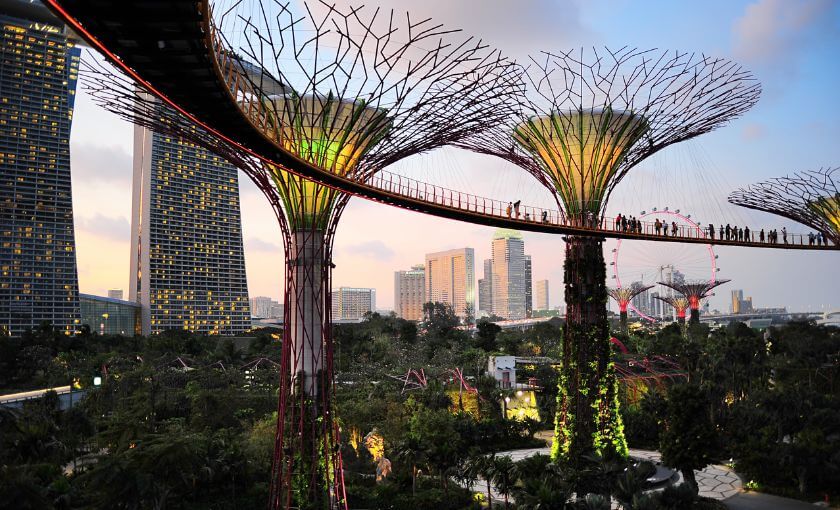As the world becomes more aware of the environmental impact of our actions, many countries are promoting sustainable building and operating practices to reduce the impact of properties on the environment. In Singapore, the Building and Construction Authority (BCA) developed the Green Mark Certification Scheme, a green building rating system to encourage sustainability and reduce the environmental impact of buildings. In this article, we will answer some of the most common questions about the Green Mark Certification Scheme.
#What is the Green Mark Certification Scheme
What is the Singapore Green Building Masterplan?
What are the benefits of the Green Mark Certification Scheme?
How do you get certified under the Green Mark Certification Scheme?
Who can apply for green Mark Certification?
What are the levels of certifications?
Are there any fees for obtaining a Green Mark rating?
How can you improve your Green Mark rating?
How can building analytics help improve a commercial buildings Green Mark certification?
How many buildings are certified under the Green Mark Certification Scheme?
What are the differences between LEED and Green Mark Certifications?
In what countries is the Green Mark Certificate used?
What is the Green Mark Certification Scheme?
The Green Mark Certification Scheme, spearheaded by the Building and Construction Authority (BCA) of Singapore, serves as a comprehensive framework for evaluating the environmental performance and sustainability of buildings. Established in 2005, this initiative aims to promote sustainability in the built environment, encouraging the adoption of green building technologies, designs, and practices across various sectors, including residential, commercial, and industrial properties.
The certification scheme operates on a tiered system, ranging from the basic "Certified" level to the highest "Platinum" award. These tiers assess a building's performance across several key criteria:
- Energy Efficiency: Evaluates the building's use of energy-efficient technologies and practices to reduce consumption.
- Water Efficiency: Assesses the implementation of water-saving measures and technologies to minimize water usage.
- Environmental Protection: Considers the building's impact on its surrounding environment, promoting the use of sustainable construction materials and practices.
- Indoor Environmental Quality: Focuses on creating healthy and comfortable indoor environments for occupants through the use of natural lighting, good air quality, and acoustic planning.
- Other Green Features and Innovations: Encourages the incorporation of innovative green features and technologies that contribute to the building's overall sustainability.
The Green Mark scheme not only acknowledges the efforts of developers and owners in sustainable building design but also serves as a benchmark for consumers and tenants seeking environmentally friendly spaces. Buildings that achieve Green Mark certification benefit from lower operating costs, increased tenant satisfaction, and a positive contribution to the global fight against climate change.
As the built environment is a significant contributor to global carbon emissions, the Green Mark Certification Scheme plays a crucial role in Singapore's national sustainability strategy. By setting rigorous standards for green building practices, the scheme not only enhances the city-state's environmental credentials but also positions Singapore as a global leader in sustainable urban development.
As a government initiative, it supports Singapore's wider strategic focus on sustainability, with national commitments captured within Singapore's Green Building Master Plan.
What is the Singapore Green Building Masterplan?
Singapore’s first Green Building Masterplan was launched in 2006 to encourage developers to embed sustainability as part of a building’s lifecycle from inception. Since its launch, the BCA has been refreshing the masterplan to expand its reach to target the greening of the wider stock of existing buildings, and encourage building occupants to change their energy consumption behaviour.
The fourth edition of the Green Building Masterplan, titled “Build Our Green Future Together”, was announced in March 2021, and aims to deliver 3 outcomes under the “80-80-80 by 2030 principle”:
- Green 80 percent of buildings by Gross Floor Area by 2030
- 80 percent of new buildings to be Super Low Energy buildings from 2030
- 80 percent improvement in energy efficiency compared to 2005 levels by 2030
What are the benefits of the Green Mark Certification Scheme?
Here are the key benefits of the Green Mark Certification Scheme:
1. Enhanced Environmental Sustainability
The primary benefit of the Green Mark Certification is its contribution to environmental sustainability. By encouraging the adoption of more energy-efficient and environmentally friendly building practices, the scheme helps in reducing the overall carbon footprint of the construction sector. This, in turn, aids in combating climate change and promotes the conservation of natural resources.
2. Improved Energy and Water Efficiency
Buildings certified under the Green Mark Scheme are designed to be more energy and water-efficient. This leads to significant reductions in utility costs over time, providing financial savings for building owners and occupants. Efficient use of resources also aligns with global efforts to achieve a more sustainable and resource-efficient future.
3. Enhanced Indoor Environmental Quality
Green Mark-certified buildings offer better indoor environmental quality, including improved air quality, natural lighting, and thermal comfort. This creates a healthier and more productive living and working environment for occupants, contributing to their well-being and satisfaction.
4. Increased Property Value and Marketability
Properties with Green Mark Certification often enjoy an increase in value and marketability. The certification is a mark of quality and commitment to sustainability, making these properties more attractive to buyers, tenants, and investors who are increasingly conscious of environmental issues.
5. Compliance with Regulatory Requirements and Incentives
In some regions, achieving a certain level of green certification is a regulatory requirement for new developments. The Green Mark Scheme helps developers meet these requirements. Additionally, certified projects may qualify for various incentives, grants, or tax benefits offered by governments to promote green building practices.
6. Corporate Social Responsibility and Brand Image
Achieving Green Mark Certification allows companies to demonstrate their commitment to sustainability and corporate social responsibility. This enhances their brand image and reputation among consumers, investors, and other stakeholders who prioritize environmental sustainability.
7. Innovation and Future-Proofing
The process of achieving Green Mark Certification encourages innovation in green building technologies and practices. It drives the construction industry towards adopting more sustainable methods, future-proofing buildings against stricter environmental regulations and the evolving expectations of occupants and society at large.

How do you get certified under the Green Mark Certification Scheme?
Here's a simplified guide to obtaining Green Mark Certification:
1. Understand the Certification Criteria
The first step in the certification process is to understand the specific criteria and requirements of the Green Mark Scheme. These criteria are designed to evaluate a building's environmental impact and performance in several key areas, including energy efficiency, water efficiency, environmental protection, indoor environmental quality, and other green features and innovations.
2. Pre-Assessment and Planning
Before applying for certification, conduct a pre-assessment to determine your building's current performance against the Green Mark standards. This phase often involves gathering data on energy and water consumption, evaluating indoor environmental quality, and identifying areas for improvement. Based on this assessment, develop a plan to address gaps and enhance the building's environmental performance.
3. Implement Sustainable Practices and Innovations
Implement the necessary measures to improve the building’s sustainability. This could involve retrofitting existing structures with energy-efficient systems, incorporating sustainable materials in construction, implementing water-saving measures, and enhancing the indoor environmental quality. Innovative green solutions that contribute to sustainability can also significantly impact the assessment.
4. Documentation and Submission
Compile and prepare the required documentation that demonstrates compliance with the Green Mark criteria. This documentation typically includes detailed descriptions of the sustainable practices and technologies implemented, as well as data and reports on the building's environmental performance. Once prepared, submit your application and documentation to the BCA for review.
5. Assessment and Inspection
After submission, the BCA will review the documentation and conduct an assessment, which may include site inspections to verify the implementation and effectiveness of the green measures. This assessment evaluates the building’s performance against the Green Mark standards to determine the level of certification.
6. Certification
If the building meets or exceeds the required standards, it will be awarded the Green Mark Certification. The level of certification awarded (Certified, Gold, GoldPLUS, or Platinum) depends on the building's performance against the criteria. This certification is a testament to the building's sustainability and environmental friendliness.
7. Continuous Improvement
To maintain or improve the Green Mark certification level, continue to monitor the building's performance and implement ongoing improvements in sustainability practices. The Green Mark Scheme encourages continuous improvement and innovation in environmental sustainability.
Who can apply for Green Mark certification?
Developers, building owners and government agencies for new and existing buildings, districts, parks, infrastructure and building interiors can receive a Green Mark certification for their project.
What are the levels of certification in the Green Mark Certification Scheme?
The Green Mark Certification Scheme offers several levels of certification to acknowledge the varying degrees of environmental friendliness and sustainability achieved by buildings. These levels are:
Green Mark Certified: This is the entry level of certification under the Green Mark Scheme. Buildings that achieve basic benchmarks of environmental sustainability and performance are awarded this certification. It recognizes efforts in incorporating basic environmental features and strategies to minimize environmental impact.
Green Mark Gold: The Gold certification is awarded to buildings that demonstrate higher environmental standards and performance compared to the basic Certified level. Buildings at this level have incorporated a broader range of environmental sustainability features and practices, showing a strong commitment to enhancing environmental performance.
Green Mark GoldPLUS (formerly known as Gold Plus): This certification level is higher than the Gold certification and is awarded to buildings that exhibit even greater environmental sustainability practices and performance. Buildings with this certification have implemented advanced environmental solutions and strategies that significantly reduce environmental impact and enhance sustainability.
Green Mark Platinum: This is the highest level of certification under the Green Mark Certification Scheme. Buildings awarded the Platinum certification are industry leaders in environmental sustainability, showcasing exceptional and innovative practices in green building design, construction, and operation. These buildings achieve the highest standards of environmental performance and are models of sustainability.
Are there any fees for obtaining a Green Mark rating?
Green Mark assessment fees are dependent on the type and size of the project applying for certification. For a comprehensive view of the different fees, visit the BCA’s website.
How can you improve your Green Mark Certification Scheme rating?
Building owners can improve their Green Mark Certification Scheme rating by implementing sustainable building practices such as:
- Energy-efficient design: Incorporating energy-efficient features such as lighting, heating, ventilation, and air conditioning systems can significantly reduce energy consumption.
- Water-efficient design: Implementing water-efficient features such as low-flow fixtures and rainwater harvesting systems can significantly reduce water consumption.
- Use of environmentally friendly materials: Using sustainable materials such as low-emission paints and recycled materials can help reduce the environmental impact of construction.
- Enhanced indoor air quality: Incorporating enhanced ventilation systems and air filtration can significantly improve indoor air quality.
How can building analytics help improve a commercial building’s Green Mark Certification?
A building analytics platform has much in common with a building energy management system (BEMS). Fundamentally, the two platforms are designed to monitor your building's operational efficiency.
Building analytics can help improve a commercial building's Green Mark Certification by providing insights into the building's energy consumption and identifying areas for improvement. In fact, one of the three strategic thrusts contained within Singapore's Green Building Master Plan is 'harnessing emerging advanced low-carbon technologies'. Building analytics software can collect and analyze data from various building systems, including HVAC, lighting, and energy meters, to identify patterns and anomalies in energy consumption.
By using building analytics, building owners and operators can pinpoint areas of inefficiency and waste and implement strategies to reduce energy consumption and improve overall building performance. For example, analytics may reveal that a building's HVAC system is consuming more energy than necessary, and adjustments can be made to optimize its performance.
Furthermore, building analytics can provide real-time insights into a building's energy performance, allowing building operators to monitor performance and adjust systems as needed. This can help ensure that the building continues to meet the required Green Mark Certification standards over time.
<a id="#How many buildings are certified under the Green Mark Certification Scheme"></a>
How many buildings are certified under the Green Mark Certification Scheme?
As of December 2023, more than 4,600 buildings in Singapore have been certified under the Green Mark Certification Scheme, covering a total gross floor area of over 146 million square meters. This number includes both new and existing buildings. As of the end 2022, close to 55% of Singapore's buildings have been 'greened'. By 2030, Singapore targets to 'green' 80% of local buildings.
What are the differences between LEED and Green Mark Certification?
LEED (Leadership in Energy and Environmental Design) certification and Green Mark certification are two renowned green building certification schemes, but they have distinct origins, geographic focuses, and evaluation criteria.
Originating in the United States, LEED has achieved global recognition, while Green Mark is a certification scheme developed by Singapore's Building and Construction Authority (BCA), specifically targeting sustainable building practices within Singapore.
When it comes to the assessment methods, LEED assesses sustainability performance using a credit-based system across various categories, whereas Green Mark evaluates environmental impact and performance based on specific benchmarks. LEED offers certification levels ranging from Certified to Platinum, while Green Mark offers Certified, Gold, GoldPLUS, and Platinum.
Additionally, LEED has regional adaptations to accommodate different countries and regions, whereas Green Mark is tailored to Singapore's unique context.
While both certifications carry market recognition, with LEED's global reach and Green Mark's strong reputation in Singapore's construction sector, commercial property owners should consider their location and specific priorities when selecting between the two.
For more information on LEED ratings, check out our blog: “The LEED Rating System Explained”
In what countries is the Green Mark Certification Scheme used?
The Green Mark Certification Scheme is primarily used in Singapore, but the BCA has also collaborated with other countries to promote sustainable building practices. These countries include Malaysia, China, Indonesia, and Mauritius.

For more information, head to Green Mark Certification Scheme
Here at CIM, we're actively helping the world's built environment to achieve net zero emissions and accelerate progress toward ambitious targets. Learn how we can help improve your Green Mark rating by watching a demo session of our innovation PEAK Platform here.

.jpeg)


.jpeg)


